Freshmen have been excluded from these previews, as we'd like to wait and see what they have to offer on the NCAA level before we come to any long-term conclusions.
-Top NBA Draft Prospects in the Big Ten, #1-5
-Top NBA Draft Prospects in the Big Ten, #6-10
-Top NBA Draft Prospects in the Big Ten, #11-15
-Top NBA Draft Prospects in the Big Ten, #16-20
-Top NBA Draft Prospects in the ACC, Part One (#1-5)
-Top NBA Draft Prospects in the ACC, Part Two (#6-10)
#11 Reggie Johnson, 6-10, Junior, Center, Miami (FL)
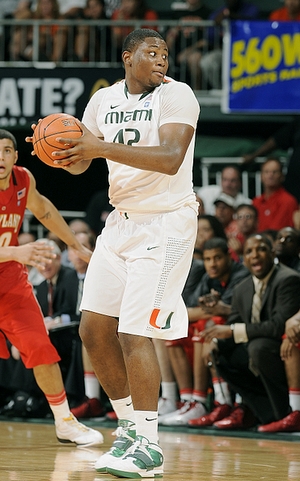
Joseph Treutlein
A bruising center who was very raw when he stepped on campus as a freshman, Reggie Johnson has made considerable strides in his first two years at Miami. He's lost an estimated 40 pounds in two years while developing into a solid contributor in the post and on the glass for the Hurricanes, and still has substantial room for more growth as a player.
Standing 6'10 with a long 7'2.5 wingspan, Reggie Johnson has a very nice frame to work with, and is already pretty mobile for a guy who weighs 307 pounds with 22.4% body fatas measured at the New Jersey Nets group workout last May. Despite not having much definition in his body, Johnson possesses terrific brute strength and has no problem using it, playing a very physical brand of basketball on the offensive end.
His weight does hold him back in terms of his ability to elevate, however, and below average conditioning is likely a contributor to playing just 26 minutes per game, so continuing to trim down his body could have multiple positive effects. Johnson unfortunately suffered a setback this summer, as he tore the meniscus in his right knee in July, which will likely keep him out until at least January, and won't help his continued efforts to maximize his physical abilities.
Looking at Johnson's game on the basketball court last season, there are numerous things to be encouraged about for a player who came onto campus as a substantial project.
Johnson does the majority of his damage operating with his back to the basket, where he shows a simple but solid repertoire of moves. He is very much reliant on a right-handed hook shot, something he shows very good touch on with range out to about eight feet. Beyond that, he does a good job using his frame to back his man down and finish with power through contact, having no qualms about bullying his way to the basket.
On the downside, Johnson does show some troubles with double teams, specifically in protecting the ball from help defenders. He also doesn't show much in terms of a left hand, and his overall repertoire is very limited beyond his right-handed hook and just overpowering his man. That said, with his size and touch, assuming he can continue to trim down and maximize his quickness and explosiveness while not sacrificing power, he may be able to get by with his limited repertoire as others in his mold have.
In terms of setting up in the post off the ball, Johnson does a good job moving to get open and is often eager to call for the ball, where he shows great hands catching entry passes. He is a bit inconsistent in terms of using his mass to establish dominant post position early, sometimes opting to settle for catching the ball in the 10-15 foot range and working to back his man down from there.
Johnson doesn't possess much in terms of perimeter abilities, showing no discernable ball-handling prowess and being very limited with his mid-range jumper. His 67% free-throw shooting (down from 79% as a freshman) isn't awful, so this is certainly something he can build upon to become a more versatile player.
Johnson does make some contributions in the pick-and-roll game, where he is occasionally featured, being surprisingly nimble for his size and doing a nice job on catch-and-finishes with his good combination of hands and touch. He actually gets quite a few dunks in this manner, showing no hesitation to elevate with power around the basket when he builds the necessary momentum to do so.
The other area Johnson makes strong contributions on the offensive end is with his rebounding, something he does consistently well on both sides of the floor. Johnson was the third best per minute rebounder in the DraftExpress database last season, as he does an excellent job using his strength and mass to carve out space around the rim, and then using his good hands, long arms and strong nose for the ball to pull in everything he can.
On the defensive end, however, Johnson is very much a work in progress, not possessing much in terms of post fundamentals, where he's often shot over and beaten around. Johnson's effort level is solid, and he shows decent timing on shot blocks despite his weak elevation, but he clearly is disadvantaged from a fundamentals and quickness standpoint. To his credit, he shows good effort when he has to close out on the perimeter, and does his best to move his feet when he's rarely matched up with an opponent on the perimeter, but clearly has a ways to go here.
Looking forward, Johnson has a nice framework of skills to work with and has the makings of a strong physical specimen if he can continue his body transformation. His work ethic and learning curve are obviously positive attributes for him, and they'll be tested to see if he can overcome his injury setback to continue his progress this season. Continuing to trim down his body while maintaining his strength, improving his post-game, developing a more reliable mid-range jumper, and putting in substantial work defensively will all be important for his stock, but he still has plenty of time left to hone his skills.
Lorenzo Brown, 6-5, Sophomore, PG/SG, North Carolina State
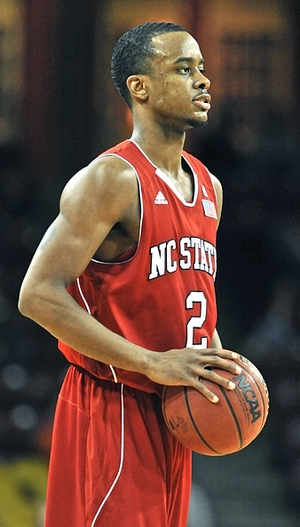
Jonathan Givony
A borderline McDonald's All-American caliber recruit coming out of high school, Lorenzo Brown was forced to spend a year in prep school improving his grades before becoming eligible to enroll at N.C. State.
Playing major minutes as a freshman on a very young team that finished 2nd to last in the ACC, Brown gained plenty of experience, but saw the coach that recruited him, Sidney Lowe, fired in the offseason.
With a new coach, Mark Gottfried, in place and his fellow freshman backcourt mate Ryan Harrow opting to transfer to Kentucky, Brown finds himself in a much different situation going into his sophomore season, already being named the team's starting point guard.
Standing somewhere between 6-4 or 6-5, Brown has excellent height for a guard, even if he clearly still has work to do on his narrow frame. He's a very fluid athlete, not overly explosive vertically, but extremely shifty and coordinated.
Brown's best virtues revolve mostly around his elegant ball-handling skills, as it's pretty clear when watching him that he's an extremely talented player for whom the game comes very naturally for. Brown can create his own shot driving in either direction, particularly in transition, and does a good job utilizing change of speeds and hesitation moves to keep his defender off balance.
Lacking a degree of strength and not terribly explosive elevating around the basket, Brown isn't always able to finish what he creates for himself inside the arc. He needs to do a better job of drawing contact around the rim and powering through opponents, as he doesn't get to the free throw line at a great rate and only converts 45% of his 2-point attempts.
He's a decent shooter with his feet set, showing solid mechanics on his jumper, but really struggled to make shots off the dribble last season, hitting just 20% of his attempts. To hold the attention of NBA scouts Brown is going to have to become a much more efficient scorer over the next few years, which means improving his ability to score inside and outside the arc, as well as getting to the free throw line.
As a distributor, Brown shows solid court vision, making some very creative passes to teammates, particularly in drive and dish situations. His ball-handling skills, ability to change speeds and size give him an excellent framework as a pick and roll threat, which we'll likely see a lot more of this season.
He was a little bit careless with the ball at times last season, though, making too many risky passes and being far too turnover pronecoughing the ball up on 23% of his possessions. He'll need to improve his decision making and leadership skills to show scouts that he in fact has the ability to play the point in the NBA, but with Ryan Harrow now out of the program, he has a great opportunity to showcase his talent in a featured role in the ACC.
Defensively is where Brown struggled the most at times last season. While he has good anticipation skills in the passing lanes and is a strong rebounder for his position, he offers very little presence in the half-court in man to man settings. Players get by him with the greatest of ease, as he lacks intensity and isn't physical at all trying to fight through screens and deny opponents a path to the basket. He seems to give up on plays too easily, while his awareness leaves a lot to be desired.
With his narrow frame, Brown might have trouble defending some of the stronger shooting guards he'd potentially encounter in the NBA, while he might not be quick enough to stay in front of most point guards. Maximizing his ability on this end of the floor should be a major focal point moving forward, as it could play a significant role in whether he's able to reach his potential at the professional level.
It will be interesting to see what kind of jump Brown is able to make from his freshman to sophomore seasons, as he doesn't seem to lack talent around him on the N.C. State roster. If he's able to build on his promising rookie year, he'll draw plenty of attention from NBA scouts.
#13, Seth Curry, 6-2, Point Guard/Shooting Guard, Junior, Duke
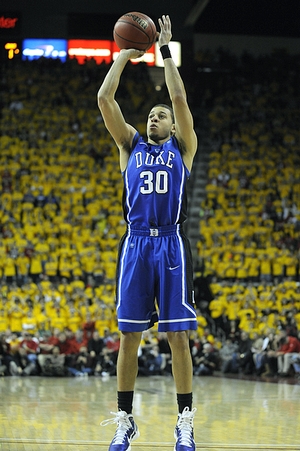
Walker Beeken
After playing more of a complimentary role off the ball last season next to 2011 first round pick Nolan Smith (and #1 overall pick Kyrie Irving when he was healthy), Seth Curry will likely have the opportunity to play more minutes and display more of his overall game in 2011-2012. While Curry will still need to earn his playing time in Duke's loaded backcourt, he seems to have emerged as the likely starter at point guard in his upcoming junior season, having started all four games at the point in Duke's exhibition tour last month in China and Dubai.
This would be the second fairly dramatic role change in Curry's college career thus far, after already having to make the adjustment to a lower usage player when he transferred from Liberty to Duke. His field goal attempts per forty minutes pace adjusted went from 18.1 as a freshman at Liberty to just 9.9 last season, as he spent much less time with the ball in his hands creating offense and more time spotting up. It will be very interesting to see how he responds this season in a role that should still be quite different than either of his previous two seasons.
As we've mentioned before, Curry's game, similar to his older brother Stephen Curry, is based on his deadly outside shooting touch, as nearly 90% of his overall shots last season were jumpers, and 62% of his field goal attempts came from beyond the arc. Used mainly as a spot up shooter last season, Curry improved his 3-point percentage from 35% in his season at Liberty to a lethal 44% last year at Duke.
He uses his threat as a perimeter shooter to open up his game off the dribble. While he lacks the explosive first step to blow by his man off the bounce, he does have an excellent feel for the game, and he knows how to change speed and direction to get his man on his heels just enough to create space for his shot or open up his driving game. He showed the ability last season to penetrate off of close-outs and find his teammates, whether it was drive-and-kicks to open shooters or nifty dishes to Duke's big men for easy buckets. His decision-making looked solid in pick-and-roll situations as well, albeit in a small sample size.
With more opportunities to handle the ball and create offense this season, it will be interesting to see if Curry has made strides as a finisher in the paint and in the mid-range. Like most smaller players who lack great explosiveness, he struggled to finish in the lane and hadn't yet developed a reliable floater or other shots to score efficiently inside the arc, as evidenced by the poor 40% he shot on 2-pointers last season, placing him last by a large margin amongst players ranked in our top-100. He also did not get to the free throw line at a high rate, just 3.5 times per-40 minutes pace adjusted, which ranks in the bottom ten of our top-100 prospects.
Playing more of the point could also change how Curry operates on the defensive end, depending on how Coach K decides to use him. He played with high intensity last season defensively, as is usually demanded at Duke, and also showed good instincts with help and in the passing lanes. Getting to see him defending the primary ball-handler more often will give scouts a better feel for whether or not he'd be able to defend the point guard position at the NBA level, where he'd face stronger and more athletic players on a regular basis.
This will be Curry's third college season in a different role, and this one should give us the best glimpse yet of his true NBA potential, as he'll likely be asked to play more like a point guard on both ends of the floor. Although he does have some physical limitations as a prospect, he'll get plenty of exposure this season at Duke, and he has the shooting stroke, feel for the game, and bloodlines that make him an intriguing player to keep an eye on.
#14 Durand Scott, 6-3, Junior, PG/SG, Miami
Not having made a great deal of progress from his freshman season, which we profiled with a comprehensive scouting report, we've elected to wait and see what type of progress Scott has made with a fresh perspective in a few months, rather than rehashing many of the same comments made last year based off his 2010-2011 game footage.
#15 Milton Jennings, 6'9, SF/PF, Clemson, Junior
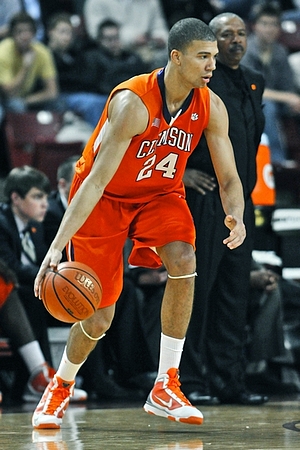
Kyle Nelson
After a disappointing freshman year, Milton Jennings's sophomore season still left something to be desired from the former McDonald's All-American. Jennings is still young, however, and he possesses the same combination of size and skill that made him such an intriguing prospect in high school.
At this point, it seems safe to project Jennings as a face-up power forward given his skill set and development at Clemson. At 6'9 with long arms and a developing 225-pound frame, he has solid size for his position, even if he must continue to get stronger. He is a decent athlete, quick in the open floor and very fluid, albeit not overly explosive, but he rarely plays to his athletic strengths due to his somewhat tentative nature and affinity for operating on the perimeter.
By the numbers, Jennings improved quite a bit last season, averaging 8.3 points per game and 16.6 points per 40 minutes pace adjusted. On film, he showed greater versatility, though with many of the same issues he struggled with as a freshman.
According to Synergy Sports Technology, 44% of Jennings' shot attempts came on jumpers, where he made just 31% of his attempts. He seems to have better potential in this area than the numbers would indicate, especially when his feet are set. He has good shooting mechanics and fluidity in his shooting motion, and very good touch. His mechanics disintegrate, however, when he's guarded or if he has to shoot off of the dribble. His 77.2% FT at least suggests his potential as a jump shooter, but he must find a way to improve upon his 29.3% 3FG as a junior.
Jennings once again shot below 50% inside of the arc, a result of his lack of toughness and inability to play through contact. He doesn't possess a very diverse back-to-the-basket game, looking comfortable only when resorting to a right handed running jump hook or turnaround jumper. He also struggles to finish through contact, being more likely to attempt a soft layup rather than trying to power through opponents and finish above the rim.
While his perimeter game is still a work in progress, he has shown potential in this area due to his high skill-level and fluid nature. He must continue to polish up his ball-handling skills, however, if he wants to be effective as a slasher or as a mid-range scorer in the future. As a sophomore, he was unable to utilize his above average first step and rarely maintained control long enough to get to the basket. Far too often, his lax handle lead to turnovers instead of easy finishes.
Furthermore, he rarely looked to pass out of trouble to open teammates, though this is indicative of what seems be a larger issue of raw instincts, focus, and court awareness on the offensive end of the floor. He averaged just 0.6 assists versus 1.9 turnovers per game for easily one of the worst assist/turnover ratios in our database. Improving his awareness on the offensive end is essential as he inherits a larger role for the rebuilding Tigers.
He shows significantly more promise on the defensive end, where his size, length, and versatility allowed him to guard power forwards and successfully switch onto wings at the collegiate level. He must continue to improve his fundamentals, add strength to his frame, and limit his fouling, a tall order for his junior season, but he shows the potential to emerge as a defensive presence at the collegiate level. He was solid on the boards last year, as well, averaging 10.6 rebounds per 40 minutes pace adjusted.
Jennings is ultimately an extremely raw prospect at this stage, but has a nice frame work of skills to build off of. The developmental trajectories of similar players, such as Justin Harper, suggest that the NBA is a possibility down the road. Unfortunately, Clemson's guard play, while less than ideal last season, continues to be sorely lacking to the point where Jennings may continue to struggle if he does not develop further as a shot creator. Regardless, he must continue to mature mentally and physically, while learning how to utilize his strengths in Clemson's offense and playing hard consistently on defense.













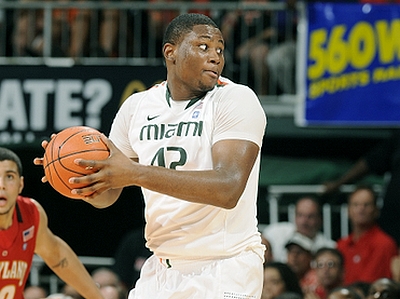
























Comments